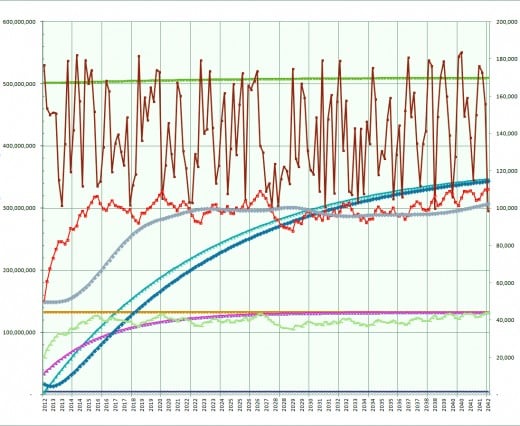System Dynamics Modeling: A Multi-Purpose Venture

System Dynamics models are often used to simulate a variety of complex systems in relatively easy to understand terms. These models are particularly good at describing counter-intuitive or unexpected complex behaviors of social systems such as societal interactions, population dynamics, or even interactions between investing and purging shares in the stock market. More than this though, the approach that the field of System Dynamics uses can have applications that go far beyond attempting to answer questions about the world around us. In fact, this type of modeling as applications in a variety of environments such as teaching, consulting, and scientific research.
Using Models in a Teaching Environment
Models are great tools for teaching because a good model can sometimes replace traditional methods of teaching such as books or videos. Students can ask questions or make predictions about how a particular system works and then use the model to answer those questions or to evaluate their predictions about how the system will behave. The models can also help the students understand the underlying relationships and interactions in system and even help them to see the world in a way that they may not have realized was possible before
For "big picture" models, students will learn that the dynamic and ever changing world around us cannot simply be described by linear extrapolation of the past. Furthermore, the root causes of some of the world's biggest problems today are not likely something that occurred recently or near to the issue. As is often the case, complex social issues often require complex solutions. Politicians who often tout the simplicity of a solution to problem have rarely seen the full picture of the issue. This is where system dynamics models can be such a great tool for teaching students (and politicians!).

One of the best things about system dynamics models is that they can show a student counter-intuitive behavior and then explain why it is happening. For example, in Jay Forrester's famous Urban Dynamics model (1969), the computer model predicted that the introduction of low cost housing options within already depressed parts of town actually perpetuated (or increased) the problem of poverty and unemployment. Obviously this is the opposite of the results desired by the politicians who wanted to reduce the problem. Of course the politicians had not intended to increase poverty and joblessness yet a model was created that showed this result.
In addition to this, modeling helps to enforce "big picture" and "long term" thinking among students. When students grasp these philosophies, their ability to think critically about the problems of the world (or problem solving in general) is greatly enhanced.
Using Models in a Research Environment
The field of system dynamics was created around the concept of using models to study, evaluate, and assess complex systems. In a research setting, models are great because they allow the researcher to run low cost experiments hundreds, if not thousands of times. However, for a model to truly be effective, it needs to be calibrated and validated. Once this has occurred, the model can be used to test a variety of scenarios which can then be used make predictions about reality.

When Jay Forrester created his Urban Dynamics (1969) and World Dynamics (1971) models, he literally changed the way we would think about the future and sustainability. His models produced results that were both disheartening at times and largely controversial. Even if his models were wrong, Forrester was still able to get the scientific community to think more deeply about sustainability (and what it would take to get there) - simply as a result of creating and running a model. Beyond system dynamics, the use of models in the research environment is pretty much standard in the world.
Using Models in a Consulting Environment
Models used in the consulting environment is where you'll find the most practical every day applications of system dynamics models. A system dynamics model can be used by a consulting firm to provide answers to questions and to help make policy recommendations to a client. A well constructed model can be used by a client for any number of tasks including: reducing costs, increasing profitability, reducing liability and even understanding things like employee turnover and inventory shortages or overruns.
Often times in business manager's witness counter-intuitive behaviors within their organization. Without the help of a model, it might not be possible for the manager to see or understand what is really going on. A consultant could produce a systems dynamics model of the business environment which could produce useful results that could be used to help understand how the system (the business operation) is functioning. The manager could analysis the model's results and trace the pattern of system relationships back one or more root causes of a problem. Once the problem areas are identified, solutions can be determined and the model can be used to predict the results of those solutions.
Conclusion
A well put together model can provide benefits beyond just answer questions about the system being modeled. There is something to be learned from every model both in the results as well as the actual model as well. Whether system dynamics models are used for teaching, research or consulting, the bottom line is that models can provide insights into a complex system that may not necessarily be obvious otherwise.



